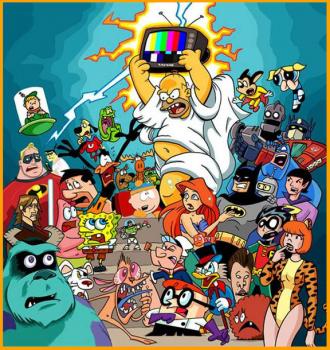
Animation is young. How young? Well, before Film was possible or even thought of, Peter Roget presented a paper called “The Persistence of Vision” that explained to the British Royal Society that a succession of images could induce the illusion of movement and life. That was in 1824- less than 200 years ago. One year later, to test his theory, the Thaumatrope optical toy is used to demonstrate and confirm Roget’s idea.
Two hundred years may not seem long ago, but to think that the first drawings were done by Prehistoric man in caves to the first animated full-length film, Snow White and the Seven Dwarfs, premiering in 1937, it seems that we’re just beginning.
Animation would not be what it is today without these Top 100 Moments that Shaped Animation History.
1. Edison patents motion picture camera. Two years later, he announces his kinetoscope which projects a 50ft length of film in approximately 13 seconds. It would be quite hard to enjoy film and animation without this hand dandy invention!
2. The Zoetrope is invented- a band of drawings inside a revolving drum that gives the illusion of movement. (1834)
3. The Kineograph, or as we know it, the “flip book” is born. (1869)
4. In 1877, Charles Emile Reynaud gets inspires to patent the Praxinoscope, similar to the zoetrope except it projects images from a strip of film with the aid of mirrors.
5. Through these innovations, Thomas Edison, in all his glorious intelligence, patents the motion picture camera. In 1889, he introduces to the world, his creation of the Kinetoscope. It projected 50ft of film in approximately 13 seconds.
6. A little over a decade later, in 1898, the first stop motion animation was created by Albert E. Smith and J. Stuart Blackton. Their creation was The Humpty Dumpty Circus.
7. J. Stuart Blackton is a major player in the early days of Animation. He made the first animated film which he called “Humorous Phases of Funny Faces.” He drew these funny faces on a blackboard while filming. He would take a frame, erase one face, then draw another.
8. In 1908 over in a little country called France, Emile Cohl produces a film which depicts white figures on a black background, the first of it’s kind. “Phantasmagorie” is considered one of the first fully animated films ever made, totaling 700 drawings and had a running time of only 2 minutes.
9. Double triumph, two years later, Emile Cohl makes “En Route” using paper cutout animation for the first time in history. Instead of having to redraw each new cell, repositioning the paper pieces saved time.
10. Cartoonist Winsor McCay produces an animated sequence using one of his well-known comics, “Little Nemo.” Thus begins a curious adventure.
11. With a handful of people bewildered by the illusion of life, multiple techniques are developed. One of these people, John R. Bray applies for a patent on numerous animation techniques- the most useful, the printing process of backgrounds.
12. Winsor McCay, dedicated to this young form, produces a cartoon called “Gertie, The Trained Dinosaur” which premiers as a vaudeville act in 1914. Winsor McCay would appear in front of an audience and interact with “Gertie” who is projected onto the screen. It was not the first cartoon but is considered to be the first with an appealing personality. The film consisted of 10,000 drawings and ran the length of 12 minutes. Audiences were stunned, and in disbelief.
13. Earl Hurd has the idea to separate elements of the final animation. Not only does it save time in redrawing the background for every active drawing, but it won’t shake! This is the birth of Cel Animation. With John R. Bray, they form Bray-Hurd Patent Company and collected royalties off of the process until 1932 when it expired. Bray was also the developer of basic division of labors that is still utilized in Animation studios. This splits the work among Animators, their assistants, clean up artists, layout artists, etc.)
14. In 1915, Max Fleischer receives a patent for the Rotoscope. The Rotoscope allows the artist to draw over live-action film, frame by frame.
15. You may remember a certain feline named Felix. Pat Sullivan created him in 1919 and was of the first most recognizable characters in film history. Otto Messmer drew him in comics and later in cartoons. Having his hey-day mainly in the Silent Era was due to his creator’s reluctance to transition into sound.
16. “The Debut of Thomas Cat” in 1920 was also the debut of the first color cartoon. The Brewster Color process made it possible allowing two colors in the final product.
17. One year later, Walt Disney animates his first film. Not Snow White, we’re years away from that! In 1921, “Newman Laugh-O-Gram” sample reel was sold to a theatre chain hoping to encourage the sale of advertising of local businesses to a broader audience.
18. After losing the copyright to his creation, Oswald the Lucky Rabbit, Walt Disney moves to California and begins “Disney Brothers Cartoon Studio” with his brother, Roy. In 1923, still in the Silent Era, they begin producing the Alice comedies.
19. Extending the Alice comedies, Walt Disney uses Max Fleischer’s technique of combining live action with cartoons to create the film, “Alice’s Wonderland.”
20. Still amidst of playing with adding color, Max and Dave Fleischer jump ahead with sound. They release “Mother Pin a Rose on Me”, a Song Car-Tunes, with Arrow Film Corp. It is the first sound cartoon and used the Lee DeForest Phonofilm sound process.
